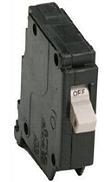Our Voltimum Experts answer your questions on a daily basis in our Technical Expertise area. This Question of the Day, concerning individual circuit isolation, where the means of isolation doesn't separate the neutral from the supply, is answered by the ECA:

Last week, I had to replace a light fitting and, of course, this involved isolating the circuit. The circuit breaker was placed in the 'OFF' position but being a single-pole device, the breaker will only isolate the line conductor, but not the neutral, which from what I understand is classified as a live conductor returning the current from the load back to the supply source. If I'm wrong here, please correct me.
My assumption was that the neutral would still be live as the neutral bar at the panel is also occupied by neutrals of other circuits, which where live. I mentioned this to the supervisor. He said: "Neutral is earth". I imagine what he meant here is that the neutral is connected to earth; most likely on the supplier's side (star point connection) and, therefore, at earth potential, i.e. zero volts. Is this right?
I did some reading on isolation in Section 5 of the On-Site Guide and Chapter 53 of the 17th Edition BS7671:2008 Regulations. Regulation 537.2.1.1 states: 'Every circuit shall be capable of being isolated from each of the live supply conductors. In a TN-S or TN-C-S system, it is not necessary to isolate or switch the neutral conductor where it is regarded as being reliably connected to earth by a suitably low impedance'.
This appears to be backed on page 33 in Section 5 of the On-Site Guide which states: 'i. at the origin of single-phase TT and TN systems, a double pole switch must be used. And for three-phase supplies forming part of a TT system, an isolator must interrupt the line and neutral conductors. But in three-phase TN-S and TN-C-S systems, only the line conductors need be interrupted'.
Also: 'ii. for every circuit other than the origin of the installation, every circuit or group of circuits that may have to be isolated without interrupting the supply to other circuits should be provided with its own isolating device. The device must switch all live conductors in a TT system and all line conductors in a TN system'.
The college training is over now, but when I was there last year, isolation was demonstrated by the workshop trainer, but this was via a double-pole switch disconnector, isolating all live conductors including the neutral. However, when studying the theory side of the course, I read that isolation can be achieved via a single-pole device (circuit breaker) and depending on the neutral arrangements, it may be necessary to remove the neutral from the neutral bar.
Could you please explain the logic behind individual circuit isolation where the means of isolation doesn't separate the neutral from the supply?
Answer: It is not necessary to isolate the neutral of a TN system if it is being worked on by a skilled person, as it should be at earth potential. Therefore, securing a breaker (single-pole) in the off position and proving dead should be sufficient.
To see many more Q & A in Voltimum UK's Experts Area, please click on the link:
www.voltimum.co.uk/consult.php?universe=consult.index.questions